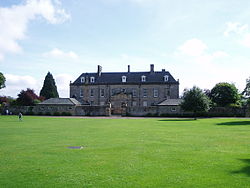Wallington Hall: Difference between revisions
No edit summary |
m →Outside links: ioe -> nhle, replaced: {{IoE|238469 → {{NHLE|1042869 |
||
| Line 31: | Line 31: | ||
*[http://www.gardenvisit.com/g/wall2.htm Wallington Hall Garden - design and history] | *[http://www.gardenvisit.com/g/wall2.htm Wallington Hall Garden - design and history] | ||
*[http://www.theblacketts.com/ The Blacketts of North East England] | *[http://www.theblacketts.com/ The Blacketts of North East England] | ||
*{{ | *{{NHLE|1042869|Wallington}} | ||
==References== | ==References== | ||
Latest revision as of 11:01, 19 September 2019
| Wallington | |
|
National Trust | |
|---|---|
 Wallington | |
| Grid reference: | NZ028842 |
| Location: | 55°9’7"N, 1°57’25"W |
| Information | |
| Website: | Wallington |
Wallington is a country house and its gardens to be found about twelve miles west of Morpeth in Northumberland, near the village of Cambo.
The estate, on the north side of the River Wansbeck, has been owned by the National Trust since 1942, after it was donated complete with the estate and farms by Sir Charles Philips Trevelyan; the first donation of its kind. It is a Grade I listed building.
History
The estate was owned by the Fenwick family from 1475 until their financial problems caused them to sell their properties to the Blacketts. The hall house was rebuilt in 1688 around the ancient pele tower house for Sir William Blackett and was later substantially rebuilt again, in Palladian style, for Sir Walter Blackett by architect Daniel Garret, before passing to the Trevelyan family in 1777. Sir Charles Trevelyan inherited the property from his father Sir George Trevelyan in 1928.
After Pauline Jermyn married the naturalist Sir Walter Calverley Trevelyan, they began hosting literary and scientific figures at the Hall. As a cultural centre, Wallington visitors included the members of the Pre-Raphaelite Brotherhood.
Set in 100 acres of rolling parkland, the estate includes a wooded dene, ornamental lakes, lawns, and a recently refurbished walled garden.
Alongside the beautifully furnished interior, attractions inside the house include the desk where Thomas Babington Macaulay, brother-in-law of the notorious Sir Charles Edward Trevelyan, wrote his History of England, a large collection of antique dollshouses and eight murals in the central hall depicting the history of Northumberland, painted by William Bell Scott.
The National Trust also own the estate of which the house is a part; the produce from these farms, as well as others in the region, was sold in a farm shop on site. The farm shop shut in 2012.
Outside links
| ("Wikimedia Commons" has material about Wallington Hall) |
- Wallington information at The National Trust
- Wallington Hall Garden - design and history
- The Blacketts of North East England
- National Heritage List 1042869: Wallington
References
- Kirtley, Allan, Longbottom, Patricia, Blackett, Martin. A History of the Blacketts. (2013) The Blacketts. ISBN 978-0-9575675-0-4. http://www.theblacketts.com/articles/187-how-to-order-your-copy-of--a-history-of-the-blacketts.
